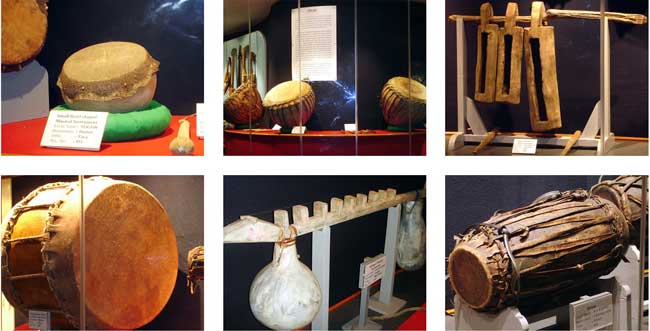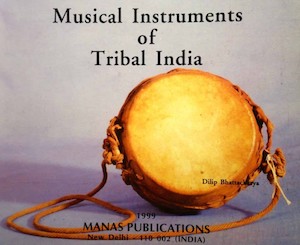
To view and learn more visit its Musical Instruments Gallery >>
More about Meghalaya >>
MUSICAL INSTRUMENTS GALLERY
Music plays an important role in the life and culture of most people in the North East. “Music is in their blood”, it is often said metaphorically. Most of the tribes of the region have a rich oral tradition and music is one way through which knowledge and folktales are transmitted through generations.
Songs and dances are often inspired by the natural environment, the annual agricultural cycle, or by historical events like war and conflicts of the past, the founding of the village, or waves of migration.
Some songs and dance forms have become famous across the country like the Manipuri Dance. This dance is called Pung or Manipuri Mridanga and represents the soul of classical Manipuri dance. The dance and music assume an important ritual character, and is an indispensable part of all social and devotional ceremonies among the Meitei community of Manipur. In this style, the dancers play the pung, which is a hand beaten drum, while they dance around acrobatically at the same time.

Its 7 floors represent the 7 states of North East India
Don Bosco Centre for Indigenous Cultures
Location: East Khasi Hills District, Shillong
A three-in-one Institution combining a museum with a research and publication centre, for promoting and preserving the rich cultural heritage of North East India -a unique fusion of all the sister states under one roof.
With seven stories, 56,000 square feet of floor space and 15,154 square feet of display wall space, it ranks among the top 36 or so cultural centres of its kind in the Salesian world. Museums/ Cultural Centres in practice appear to be a significant aspect of the Salesian mission
Even in terms of design the DBCIC is startling: built in hexagonal shape, its seven floors represent the seven states of North East India. The building rises to form a flame, expressing the reality that if cultures are understood well, they can form a communion of cultures for a better society.
DBCIC contains seventeen galleries displaying cultural artefacts and paintings. It offers study and research facilities throughout its specialised library of 10,000 volumes, a media hall and a conference hall. It is frequented by school students and older research students and anthropologists, since this area of India is an anthropologist’s paradise.
Don Bosco Museum
Don Bosco Centre for Indigenous Cultures (DBCIC)
Mawlai, Shillong – 793 008, Meghalaya, INDIA
Museum Timings:
Monday – Saturday
Summer: 9:00 am to 5:30 pm
Winter (1 Dec to 31 Jan): 9:00 am to 4:30 pmSunday Closed
Museum Holidays:
The Museum remains open throughout the year EXCEPT Sundays, 1 January, 26 January, 31 January, 15 August, 2 November, second last Monday in November, 22 to 25 December (both days inclusive), 31 December and Thursday before Easter to Easter Monday (both days inclusive).For more information contact:
Director,
DBCIC, Mawlai, Shillong – 793008,
Meghalaya, India
India Tel: +91 364 2550260
Tele-Fax: +91 364 2550261
Mob: +91 94361 18732
E-mail: jputhen[at]gmail[dot]com / dbcicshillong[at]gmail[dot]com
Website: www.dbcic.org / www.dbcickids.com
Blog: www.dbcic.blogspot.com
Source: Mesmerizing Meghalaya – The Official Website of Meghalaya Tourism
Address: https://megtourism.gov.in/museum.html
Date Visited: 19 March 2020
Don Bosco Museum in Shillong is a major tourists’ spot providing a glimpse of the rich and multi-cultural lifestyles of the indigenous peoples of North East India.
Source: Don Bosco Center for Indigenous Cultures
Address: https://dbcic.org
Date Visited: 1 May 2020
Research the above issues with the help of Shodhganga: A reservoir of theses from universities all over India, made available under Open Access >>
Related posts

Musical Instruments of Tribal India
by Dilip Bhattacharya >>
See also
Audio | Santali Traditional and Fusion Songs: Ghosaldanga Bishnubati Adibasi Trust – West Bengal
Crafts and visual arts | Masks
India’s tribal, folk and devotional music: Secular and ceremonial songs
Memory of the World Programme – Unesco
Music and dance | Musicology | Adivasi music and the public stage by Jayasri Banerjee
Video | Banam lutes and fiddles of the Santal people – Jharkhand & West Bengal
Video | Celestial Dancers of Manipur
Video | Cultural traditions of the Halakki people – Karnataka
Video | Khasi musical heritage of Meghalaya
Video | Kota women’s dance: Shivaratri celebrations – Nilgiris – Tamil Nadu
Video | Santali video album “Ale Ato” (Our Village, Part 1 of 2) – West Bengal
Video | South Gujarat tribal music documentation by Bhasha – Gujarat
Video | Tribes in Transition-III: “Indigenous Cultures in the Digital Era”
Video | Safe contents for educational use on many topics (music, visual arts and more)